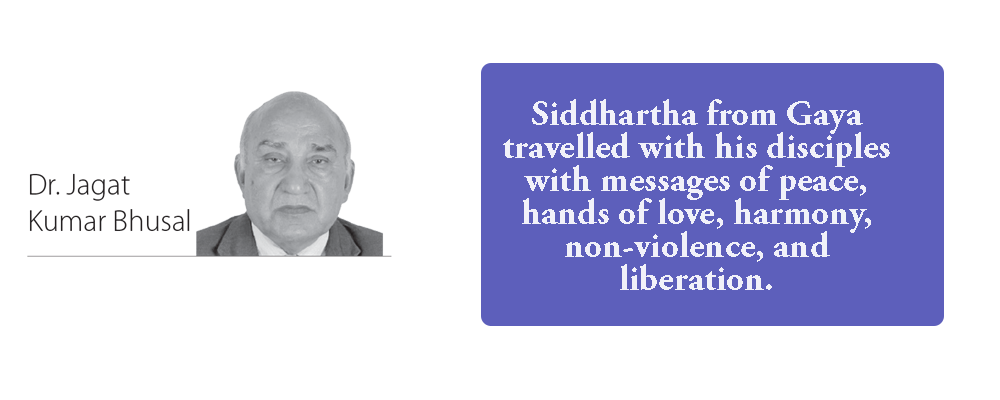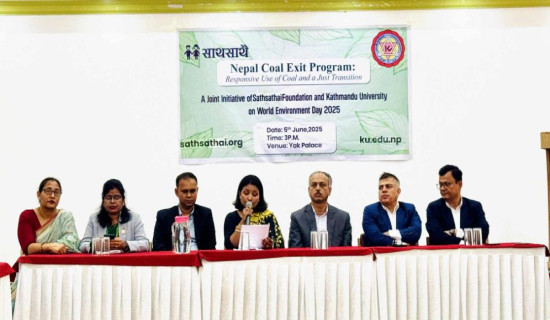- Saturday, 7 June 2025
Buddha Jayanti
Enlightenment Sprouted In Lumbini
Siddhartha, the founder of Buddhism, was born in Lumbini in 563 BC. His father was Suddhodhana and his mother was Maha Maya. Buddha attained Parinirvana in 483 BC after imparting enlightenment for 45 years. On the night of her conception, Maha Maya had a dream of bathing in the sacred cold Mansarovar Lake, and a divine spirit requested her to become his mother after the bath. The dream was interpreted that she would have a prince. Behaviour and psychological science consider dreams to be reflections of bodily states and emotions.
The feeling of cold is felt either due to increased body temperature or due to increased coldness in the living environment. Maha Maya's dream of a cool environment could also be linked to the climate-temperature genius nexus. While on the way to her maternal home, Maha Maya gave birth to a son while standing and holding the branch of the Sal-tree at Lumbini. Siddhartha was a breech birth, a rare birth with feet coming first and reaching the ground as if he had been born standing. Like every new-born, Siddhartha had the first feeling while ‘out of the womb’ was the temperature of the open garden climate, and the buzzing of bees, and the sweet hum of birds.
Cognitive intelligence
Jesus Chris's birth time environment was also cool with mild cold winds. The climate-temperature genius nexus hypothesis, as presented by this writer himself, says that the heat energy variation plays a vital role as a kind of fertiliser for the germination of genius brains. Maha Maya returned to Tilaurakot from Lumbini. On the fifth day of the birth, the naming ceremony was performed based on Hindu astrology. Jean Piaget and Fuhrman both believe that adolescence is a sensitive period for cognitive control and memory development. Children's giftedness or cognitive intelligence development is the growth of a child's ability to think and reason and being able to understand his thoughts, organising and mundane dimensions in a real and factual sense.
Suddhodhana had created a luxurious environment for Siddhartha to bring him to change, but his attempts failed as he had already reached enlightenment since childhood. Therefore, the birth and germination of Buddhism had taken place in Lumbini and Tilaurakot, not in Bodh Gaya. During a drought year, there was a dispute between the farmers of Shakya State and Kolian State over the use of Rohini River water. Siddhartha, who had attained the consciousness of non-violence, decided to stop the war and violence by standing in the middle of the Rohini River. Due to his attempt, war was stopped.
Buddha gave a sermon to both groups gathered to fight to own Rohini water right, 'You are living with malice and hatred, I am free from malice and hatred. You are trying to develop selfishness and enmity, but I do not try to develop selfishness'. This event is another strong logic that the core of Buddhism had been already maturing in Tilaurakot, not in Bodh Gaya. Siddhartha’s education started at the age of eight. He owned a passion for meditation since the age of ten and adopted meditation as an important path in life. He used to practice it in his spare time. He had refused to join any hunting parties, kill animals, or hurt anyone since his childhood.
His teenage nature suggests that the core of Buddhism had already started maturing in Tilaurakot, Lumbini, not in Bodh Gaya. Siddhartha left his family at the age of 29 when he saw the 'four big scenes' - the old, the sick, the dead, and the homeless. Dr. Ambedkar disagrees by saying that Buddha noticed such scenes only at the age of 29 years. For six years, Siddhartha travelled to many places, engaging in various yogic disciplines. He kept searching for remedies for aging, sickness, death, suffering, and a path of liberation from impurity.
When reached Gaya, he practiced abstinence under the canopy of a Peepal tree. Influenced by Vedic philosophy, he adopted austerities to acquire divine gifts, power, or knowledge. But even reaching near death from his vigilant fasting, he could not get answers. He abandoned Dhyana by eating a bowl of milked rice given by a young girl. He realised that physical austerity was not the means to achieve spiritual liberation. Verses 5, 6, and 19 of Chapter 17 of Gita also say that Dhyana giving extreme torture to the body is worthless and a failure. However, history was made differently that Siddhartha had received Bodhisattva 'Great Awakening' (Mahabodhi) under the Bodhi tree in Bodh Gaya.
Eightfold paths
Followers had ignored the fact that Siddhartha did not emaciate even after fasting for 49 days. Buddha himself concluded that practicing fasting meditation only increases suffering and body absorption. The essence of those Eightfold Paths by Buddha, including the right view, resolution, words, actions, livelihood, perfect effort, thought, and concentration, was achieved in Tilaurakot since his childhood. But Siddhartha, as a prince, could not find a suitable environment to disseminate Bodhiswotta in Tilaurakot of Kapilvastu as his father had always attempted to make him a great king, not a religious teacher.
However, it is univocal that Siddhartha had begun taking the status of Lord Buddha from Gaya. In Hindu tradition, an ascetic is reputed as an ideal being. During the development of society, there used to be group fights/slaughters/bloodshed between tribes, communities, and states. On the contrary, Siddhartha from Gaya travelled with his disciples with messages of peace, hands of love, harmony, non-violence, and liberation. Siddhartha's daily actions and messages became influential and motivating factors in the masses. Wherever he went, wherever his followers went, Siddhartha became Lord Buddha, and ideas were propagated as Buddhism. Today Gautama Buddha is a symbol of non-violence. Thus, born in Lumbini and brought up in Tilaurakot, non-violence, and Buddhism bloomed before Parivrajaka.
(The author was former chairman of erstwhile Electricity Tariff Fixation Commission and the author of the book ‘Climate-Temperature Genius Nexus’.)

















